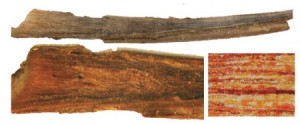 Scientists have long used whale blubber as a record of the chemicals that these enormous creatures absorb, but analysis of blubber does not indicate WHEN chemical contamination occurred, or how long it lasted. This is where two professors from Baylor University stepped in. Stephen Trumble, Ph.D., and Sascha Usenko, Ph.D. have devised a rather unusual method to determine lifetime chemical exposures and hormone profiles (from birth to death) for an individual whale using the whale’s earwax.
Scientists have long used whale blubber as a record of the chemicals that these enormous creatures absorb, but analysis of blubber does not indicate WHEN chemical contamination occurred, or how long it lasted. This is where two professors from Baylor University stepped in. Stephen Trumble, Ph.D., and Sascha Usenko, Ph.D. have devised a rather unusual method to determine lifetime chemical exposures and hormone profiles (from birth to death) for an individual whale using the whale’s earwax.
Whale earwax is a fat-rich deposit that stores the same chemical data as blubber, the difference is that it also records time — similar to tree growth rings, the wax is laid down in bands, with each band correlating roughly to a six-month period. In baleen whales, earwax forms a solid plug that remains intact even after its death.
Trumble and Usenko were able to extract and analyse the stress hormone cortisol, testosterone, organic contaminants such as pesticides and flame retardants, and mercury from a blue whale. This demonstrates that chemicals are recorded and archived in whale earwax. (For more, see: Proceedings of the National Academy of Sciences of the United States of America) which means that we can now start to assess human impact on whales.










0 Comments